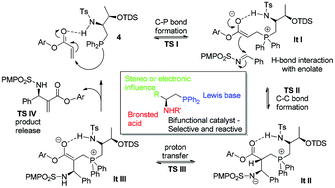The origin of enantioselectivity in the l-threonine-derived phosphine–sulfonamide catalyzed aza-Morita–Baylis–Hillman reaction: effects of the intramolecular hydrogen bonding†
Abstract

* Corresponding authors
a
Division of Physical Sciences and Engineering and KAUST Catalysis Center, King Abdullah University of Science and Technology, Thuwal 23955-6900, Saudi Arabia
E-mail:
hkw@kaust.edu.sa
b
Department of Chemistry, National University of Singapore, 3 Science Drive 3, Singapore 117543
E-mail:
chmlyx@nus.edu.sg
c The Key Laboratory of Low-carbon Chemistry & Energy Conservation of Guangdong Province and State Key Laboratory of Optoelectronic Materials and Technologies, Sun Yat-sen University, Guangzhou, China

 Please wait while we load your content...
Something went wrong. Try again?
Please wait while we load your content...
Something went wrong. Try again?
R. Lee, F. Zhong, B. Zheng, Y. Meng, Y. Lu and K. Huang, Org. Biomol. Chem., 2013, 11, 4818 DOI: 10.1039/C3OB40144H
To request permission to reproduce material from this article, please go to the Copyright Clearance Center request page.
If you are an author contributing to an RSC publication, you do not need to request permission provided correct acknowledgement is given.
If you are the author of this article, you do not need to request permission to reproduce figures and diagrams provided correct acknowledgement is given. If you want to reproduce the whole article in a third-party publication (excluding your thesis/dissertation for which permission is not required) please go to the Copyright Clearance Center request page.
Read more about how to correctly acknowledge RSC content.
 Fetching data from CrossRef.
Fetching data from CrossRef.
This may take some time to load.
Loading related content
